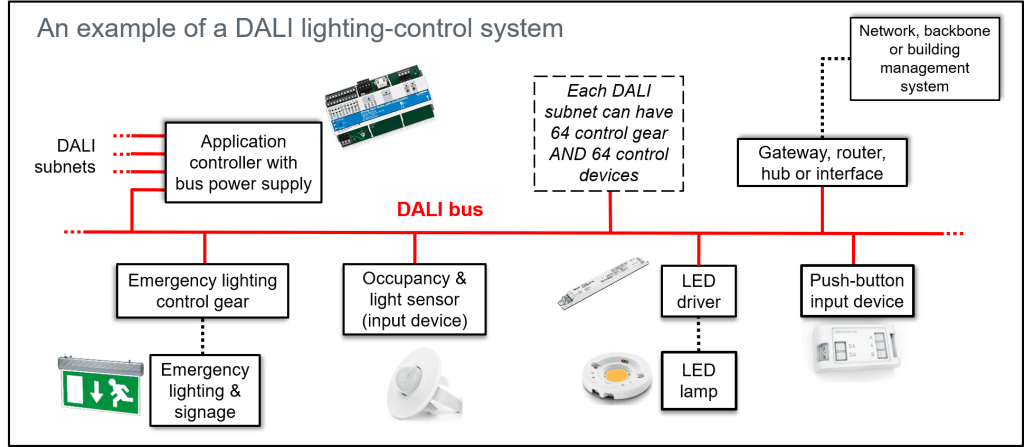Lighting is an essential part of any building, whether commercial or residential. In search of greater efficiency and control, a dedicated communication protocol called DALI (Digital Addressable Lighting Interface) has been developed.
DALI allows for more advanced and flexible lighting management, and in this article, we will explore what DALI is, its key features, its evolution to DALI-2 and why it is relevant in the lighting world. We will also learn about the DALI Alliance, the organization behind this protocol.
What is DALI?
DALI, or Digital Addressable Lighting Interface, is a communication protocol designed specifically for digital lighting control. Its primary goal is to simplify the installation of robust, scalable and flexible lighting networks. DALI was originally developed to replace analog 0/1-10V control systems, which had limitations in terms of control and configuration.

Key features of DALI
Precise and flexible control
With DALI, precise and flexible lighting control can be achieved. Each DALI device can receive individual commands, enabling digital control of specific devices. In addition, DALI devices can be grouped together to create customized lighting scenes to suit different environments and needs.
2. Two-way communication
One of the most outstanding advantages of DALI is its bi-directional communication capability between devices. This means that devices can send status information, report faults or respond to queries about their status, which facilitates lighting monitoring and maintenance.
3. Simplified wiring
DALI simplifies wiring, as power and data are transmitted over the same pair of wires, eliminating the need for separate bus cables. In addition, there is no need to worry about the polarity of the wires, minimizing wiring errors.
4. International standards
DALI is a standardized protocol and is specified in the international standard IEC 62386. It has evolved over time, and the most recent version is DALI-2, which is certified under the DALI-2 certification program developed by the DALI Alliance.
DALI-2: The Evolution of DALI
DALI-2 is an improved version of the original DALI standard. Unlike DALI, DALI-2 addresses some of the key challenges and presents significant improvements:
Improved compatibility and interoperability 2.
One of the key differences between DALI and DALI-2 is interoperability. DALI-2 is specifically designed to ensure that devices from different manufacturers work together more effectively. This reduces the compatibility problems sometimes experienced with DALI.
Advanced functionality
DALI-2 extends the functionality of DALI by enabling luminaire color temperature control, real-time error detection and support for more advanced sensors. This gives users more options and capabilities to customize lighting to their needs.
3. Continuous upgrades
Unlike DALI, which has remained relatively static, DALI-2 is continuously being developed. Future upgrades and developments are expected to build on the foundation of DALI-2, ensuring that it is ready for the changing demands of the lighting industry.

In summary, DALI and DALI-2 are communication standards designed to simplify lighting management in commercial and residential buildings. DALI offers precise and flexible control, while DALI-2 enhances interoperability and functionality, making it a preferred choice for intelligent lighting systems. If you are considering implementing a lighting control system, DALI-2 is the recommended choice due to its advantages in terms of compatibility, advanced functionality and readiness for future developments in intelligent lighting.
DALI Alliance: Driving DALI-controlled lighting forward
The DALI Alliance, also known as the Digital Illumination Interface Alliance (DiiA), is a global industry organization dedicated to lighting control using the standardized Digital Addressable Lighting Interface (DALI) protocol.
What is the DALI Alliance (DiiA)?
The DALI Alliance is an open, global consortium of lighting companies. Its main objective is to foster the growth of the market for lighting control solutions based on the standardized DALI protocol. This consortium was established in response to industry requests for an independently verified certification program, known as DALI-2, based on the latest version of the DALI protocol.
DALI-2 Certification
Certification of DALI-2 products by the DALI Alliance promises significantly improved interoperability and additional functionality compared to current DALI systems on the market. Only products that have successfully completed the DALI-2 certification process may use the DALI-2 logo trademarks. In addition, only members of the DALI Alliance can certify their products.
Development of test specifications
The DALI Alliance develops test specifications that allow companies to test their products to meet DALI-2 requirements. These test specifications are derived by the DALI Alliance from the IEC 62386 international standard in multiple parts or from DiiA specifications.
Founding Members
The DALI Alliance was formed by seven leading lighting companies: Erco, Helvar, Insta, Lutron, Osram, Philips Lighting and Tridonic. However, it is an open, non-profit organization and always welcomes new members to join.
Partnership with IEEE-ISTO
The DALI Alliance is an Associate Program of IEEE-ISTO, an international federation of leading industry groups and consortia dedicated to the advancement of standardized technologies for the benefit of industry.
Vision and Mission
The vision of the DALI Alliance is to grow the market for lighting control solutions based on DALI technology, offering significantly improved interoperability and functionality compared to current DALI systems on the market.
Its mission includes defining, standardizing, launching and maintaining a testing, certification and logo licensing program for DALI-2, the latest version of the DALI protocol. It also strives to enable continuous improvements in the interoperability of systems from multiple manufacturers, protect and enhance the value of the technology and certification program, and accelerate the development of new functionality beyond the current IEC 62386 standard.
Collectively, the DALI Alliance plays a pivotal role in advancing DALI lighting control technology, promoting innovation and efficiency in the digitally controlled lighting industry.

